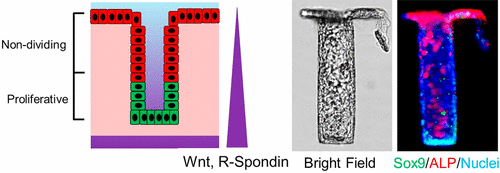当前位置:
X-MOL 学术
›
ACS Biomater. Sci. Eng.
›
论文详情
Our official English website, www.x-mol.net, welcomes your feedback! (Note: you will need to create a separate account there.)
In Vitro Generation of Mouse Colon Crypts
ACS Biomaterials Science & Engineering ( IF 5.8 ) Pub Date : 2017-09-13 00:00:00 , DOI: 10.1021/acsbiomaterials.7b00368 Yuli Wang 1 , Dulan B. Gunasekara 1 , Peter J. Attayek 2 , Mark I. Reed 1 , Matthew DiSalvo 2 , Daniel L. Nguyen 1 , Johanna S. Dutton 2 , Michael S. Lebhar 1 , Scott J. Bultman 3 , Christopher E. Sims 1 , Scott T. Magness 2 , Nancy L. Allbritton 1, 2
ACS Biomaterials Science & Engineering ( IF 5.8 ) Pub Date : 2017-09-13 00:00:00 , DOI: 10.1021/acsbiomaterials.7b00368 Yuli Wang 1 , Dulan B. Gunasekara 1 , Peter J. Attayek 2 , Mark I. Reed 1 , Matthew DiSalvo 2 , Daniel L. Nguyen 1 , Johanna S. Dutton 2 , Michael S. Lebhar 1 , Scott J. Bultman 3 , Christopher E. Sims 1 , Scott T. Magness 2 , Nancy L. Allbritton 1, 2
Affiliation

|
Organoid culture has had a significant impact on in vitro studies of the intestinal epithelium; however, the exquisite architecture, luminal accessibility, and lineage compartmentalization found in vivo has not been recapitulated in the organoid systems. We have used a microengineered platform with suitable extracellular matrix contacts and stiffness to generate a self-renewing mouse colonic epithelium that replicates key architectural and physiological functions found in vivo, including a surface lined with polarized crypts. Chemical gradients applied to the basal–luminal axis compartmentalized the stem/progenitor cells and promoted appropriate lineage differentiation along the in vitro crypt axis so that the tissue possessed a crypt stem cell niche as well as a layer of differentiated cells covering the luminal surface. This new approach combining microengineered scaffolds, native chemical gradients, and biophysical cues to control primary epithelium ex vivo can serve as a highly functional and physiologically relevant in vitro tissue model.
中文翻译:

小鼠结肠隐窝的体外产生
有机体培养对肠道上皮的体外研究产生了重要影响。然而,在类器官系统中尚未概括体内发现的精致结构,腔可及性和谱系区室化。我们已经使用了具有适当的细胞外基质接触和刚度的微工程平台,以产生自我更新的小鼠结肠上皮,其复制体内发现的关键结构和生理功能,包括衬有极化隐窝的表面。应用于基底-腔轴的化学梯度将干细胞/祖细胞分隔开,并促进了体外的适当谱系分化隐窝轴,使组织具有隐窝干细胞小生境以及覆盖腔表面的分化细胞层。这种将微工程支架,天然化学梯度和生物物理线索结合起来以控制离体上皮细胞的新方法可以用作功能强大且与生理相关的体外组织模型。
更新日期:2017-09-13
中文翻译:

小鼠结肠隐窝的体外产生
有机体培养对肠道上皮的体外研究产生了重要影响。然而,在类器官系统中尚未概括体内发现的精致结构,腔可及性和谱系区室化。我们已经使用了具有适当的细胞外基质接触和刚度的微工程平台,以产生自我更新的小鼠结肠上皮,其复制体内发现的关键结构和生理功能,包括衬有极化隐窝的表面。应用于基底-腔轴的化学梯度将干细胞/祖细胞分隔开,并促进了体外的适当谱系分化隐窝轴,使组织具有隐窝干细胞小生境以及覆盖腔表面的分化细胞层。这种将微工程支架,天然化学梯度和生物物理线索结合起来以控制离体上皮细胞的新方法可以用作功能强大且与生理相关的体外组织模型。



























 京公网安备 11010802027423号
京公网安备 11010802027423号